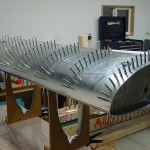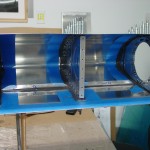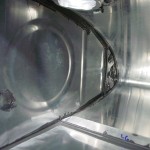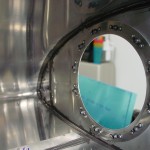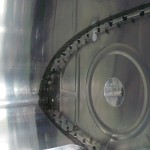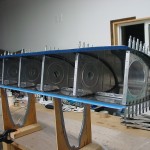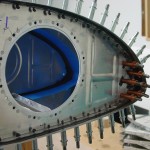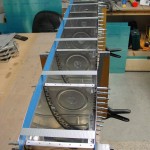Left tank rib sealing
Hours: 3.1 | Posted in Fuel TanksLeft tank is on it’s way; sealed in the ribs tonight. In addition to using the fay sealing method, I did a slightly different order than the manual specifies. First, clecoed #2 & 6 ribs in place (without sealant) to hold the skin in proper curvature. Sealed and 100% clecoed the #4, then #3 & #5 ribs, followed by the #1 and #7 ribs, at which point I removed the sealant-less 2 & 6, reinstalling them with sealant. The ribs slid into place much easier now that they’re dimpled and lubricated with Proseal. I typically pushed them into place, caught a couple holes on the aft bottom with clecoes, pushed the top row of holes into close alignment, dropped in a couple clecoes on the aft top, then used the awl to move the rib into place; once the dimples nested, it held itself in easily, whereupon I clecoed every hole.
I squeezed the reinforcement plate rivets on the outboard rib and gooped the inside heads with sealant before installing that rib to the skin; the inboard rib rivets can’t yet be installed, because they also attach the tank-t-fuselage angle, which is too think to install before riveting the rib rivets (the thickness of the material interferes with access for bucking or suqeezing those rivets). So, instead, I sealed & clecoed the reinforcement plate to the inboard rib, figuring that the sealant will hold it in place nicely once it’s cured; should be a simple task then to install the bracket & rivet.
After installing all the ribs, I went back and did the fillets around the edges with a popsicle stick (actually, it’s a tounge depressor with once end ground down to a narrower radius; provides a radius tip for filleting at the end of a triangular section, useful for “spatula-ing” sealant into places where it’s needed). I also ran strips of duct tape at each rib location to hold the aft edges of the skin closer together, into the position theyd be held when the baffle is in place. I noticed that the skin wanted to pull open due to its curvature and lack of rear baffle to hold it together. I think the tape strips will take some of the pressure off the aft-most clecos, allowing them to do their job of holding the skin more tightly to the ribs. The blue tape is to confine the mess of the filleting near the ribs; installing the ribs for some reason wasn’t as messy as the stiffeners seemed to be, and I think it would have been fine without the tape (which was removed after the fillets were in place).
